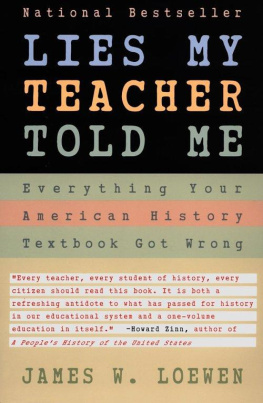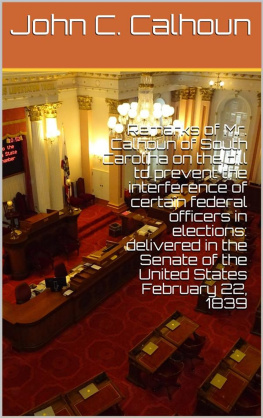We offer to read an annotation, description, summary or preface (depends on what the author of the book "Confederate States of America;États confédérés dAmérique;États-Unis;États-Unis" wrote himself). If you haven't found the necessary information about the book — write in the comments, we will try to find it.
Introduction. Unknown well-known documents. -- The gathering storm (1787-1860) -- Debate over slavery at the Constitutional Convention, August 21-22, 1787 -- John C. Calhoun (1782-1850), On Abolition Petitions, U.S. Senate, February 6, 1837 -- Alabama Platform, February 14-15, 1848 -- John C. Calhoun (1782-1850), Address to the Southern People, U.S. Senate, January 22, 1849 -- James H. Thornwell (1812-62), The Rights and the Duties of the Masters, May 26, 1850 -- Resolves of the Southern Convention at Nashville, June 10-11, 1850 -- Journal, Resolution, and Ordinance, State Convention of South Carolina, April 26-30, 1852 -- Two images of slavery: Confederate $100 bill (1862) and Obelisk, Fort Mill, South Carolina (1895) -- Samuel A. Cartwright (1793-1863), Diseases and Peculiarities of the Negro Race, 1851 -- Slave Jail, Alexandria, c. 1859 -- Jefferson Davis (1808-89), Endorsement; T.L. Clingman (1812-97), Endorsement; and J.H. Van Evrie (1814-96), Negroes and Negro Slavery, The First an Inferior Race-The Latter, Its Normal Condition, 1853 -- George Fitzhugh (1806-81), Cannibals All! Or Slaves Without Masters, 1857 -- Alexander H. Stephens (1812-83), Speech on the Bill to Admit Kansas as a State under the Topeka Constitution, House of Representatives, June 28, 1856 -- Jefferson Davis (1808-89), Speech at State Fair, Augusta, Maine, September 29, 1858 -- John B. Gordon (1832-1904), An Address Delivered Before the Thalian & Phi Delta Societies of Oglethorpe University, June 18, 1860 -- ;The nadir of race relations (1890-1940). -- J.L.M. Curry (1825-1903), The Southern States of the American Union,1895 -- Stephen D. Lee (1833-1908), The Negro Problem, 1899 -- White Mob Burns Black Businesses in Wilmington , North Carolina, November 10, 1898 -- S.A. Cunningham (1843-1913), MKinley, Roosevelt, and the Negro, January 1903 -- S.A. Cunningham, Problem of the Negroes, January 1907 -- John Sharp Williams (1854-1932), Issues of the War Discussed, November 1904 -- John Singleton Mosby (1833-1916), Letter to Sam Chapman, July 4, 1907 -- E.H. Hinton (1852-1916), The Negro and the South: Review of Race Relationships and Conditions, August 1907 -- South Carolina Confederate Womens Monument, 1912 -- C.E. Workman, Reconstruction Days in South Carolina, July 1921 -- Mildred Rutherford (1852-1928), The War Was Not a Civil War, January 1923 -- Susan Lawrence Davis (1862-1939), The First Convention, 1924;Richard Taylor (1826-79), Edmund Kirby Smith (1824-93), Treatment of African American Prisoners of War, June 8, 13, 16, 1863 -- Fort Pillow Massacre, April 12, 1864 -- John R. Eakin (1822-55), The Slave Soldiers, June 8, 1864 -- Henry Hotze (1833-87), The Negros Place in Nature, December 10, 1863 -- Robert E. Lee (1807-70), Letter to Hon. Andrew Hunter, January 11, 1865 -- Macon Telegraph, Editorial Opposing Enlistment of African Americans; January 6, 1865 -- Howell Cobb (1815-68), Letter to James A. Seddon, Secretary of War, January 8, 1865 -- J.H. Stringfellow (1819-1905), Letter to President Jefferson Davis, February 8, 1865 -- General Orders, No. 14, An Act to Increase the Military Force of the Confederate States, approved March 13, 1865 -- Reconstruction and fusion (1866-1890). -- Reconstruction and Fusion (1866-1890) -- Edmund Rhett Jr., Letter to Armistead Burt, October 14, 1865 -- Mississippis Black Code, November 24-29, 1865;John E. Rankin (1882-1960), Forrest at Brices Cross Roads, August 1925 -- The civil rights era, 1940. -- Richard Weaver (1910-63), Selections from The Southern Tradition at Bay, 1943 -- M. Clifford Harrison (1893-1967), The Southern Confederacy-Dead or Alive? December 1947 -- Dixiecrat Convention, Birmingham, Alabama, July 1848 -- Birmingham Post Staff writers, Untitled Sidebars about the Dixiecrat Convention, July 17, 1948 -- Strom Thurmond (1902-2003), Address to the State Convention of the United Daughters of the Confederacy at Winthrop College, South Carolina, October 17, 1957 -- Sumter L. Lowry (1893-1985), the Federal Government and Our Constitutional Rights, Address to the United Daughters of the Confederacy, October 15, 1958 -- The Citizens Council Logo, March 1957 -- His Example Inspires Our Efforts of Today, The Citizens Council, June 1956 -- W.E. Rose, The Warning of Robert E. Lee, The Citizens Council, February 1957;Sonny Perdue (1946- ), Confederate History Month Proclamation, March 5, 2008 -- Frank Conner, Where We Stand Now: And How We Got Here, September 2003 -- Concluding words.;Robert E. Lee (1807-70), Testimony before the Congressional Joint Committee on Reconstruction, February 17, 1866 -- Rushmore G. Horton (1826-68), A Youths History of the Great Civil War in the United States from 1861 to 1865, 1867 -- Jack Kershaw (1913-), Statue of Nathan Bedford Forrest, 1998 -- Edward A. Pollard (1831-72), The Lost Cause Regained, 1868 -- Alexander H. Stephens (1812-83), Conclusion, A Constitutional View of the Late War Between the States, 1868 -- Robert E. Lee (1807-70), the White Sulphur Manifesto, August 26, 1868 -- John B. Gordon (1832-1904), To the Colored People, address in Charleston, South Carolina, September 11, 1868 -- Ku Klux Klan Postcard, c. 1937 -- R. L. Dabney (1820-98) Womens Rights Women, 1871 -- Jubal A. Early (1816-94), Speech to the Southern Historical Society, August 14, 1873 -- Jefferson Davis (1809-89), Slavery Not the Cause, but an Incident, 1881;-- Civil War (1861-1865.) -- Jefferson Davis (1809-89), Farewell to the U.S. Senate, January 21, 1861 -- Jefferson Davis (1809-89), Message to the Confederate Congress about Ratification of the Constitution, April 29, 1861 -- The Constitution of the Confederate States of America, March 11, 1861 -- Alexander H. Stephens (1812-83), African Slavery: The Corner-Stone of the Southern Confederacy, March 22, 1861 -- Governor H. M. Rector (1816-99), Letter to Colonel Sam Leslie, November 28, 1861 -- Three National Flags of the Confederacy, 1861, 1863, 1865 -- William T. Thompson (1812-82), Proposed Designs for the 2nd National Confederate Flag, April-May 1863 -- Jefferson Davis (1809-89), Message to the Confederate Congress, January 12, 1863 -- Confederate Congress, Response of the Confederate Congress to Message from Jefferson Davis on the Emancipation Proclamation, May 1, 1863;Secession (1859-1861). -- South Carolina General Assembly, Resolutions for a Southern Convention, December 22,1859 -- Jefferson Davis, Congressional Resolutions on Relations of States, U.S. Senate, March 1, 1860 -- Official Proceedings of the Democratic Convention, April 28-May 1, 1860 -- Benjamin Palmer (1818-1902), Thanksgiving Sermon, November 29, 1860 -- Christiana Banner, 1994 (1911,1851) -- South Carolina Secession Convention, Declaration of the Immediate Causes Which Induce and Justify the Secession of South Carolina from the Federal Union, December 24, 1860 -- South Carolina Secession Convention, The Address of the People of South Carolina, Assembled in Convention, To the People of the Slaveholding States of the United States 1861, December 24, 1860 -- Mississippi Secession Convention, A Declaration of the Immediate Causes Which Induce and Justify the Secession of the State of Mississippi from the Federal Union, January 26, 1861 -- Florida Secession Convention, Cause for Secession, January 7, 1861 -- Alabama Secession Convention, Resolution of Resistance, January 7, 1861, and Ordinance of Secession, January 11, 1861 -- Georgia Committee of Seventeen, Report on Causes for Secession, January 29, 1861 -- Texas Secession Convention, A Declaration of the Causes Which Impel the State of Texas to Secede from the Federal Union, February 2, 1861 -- George Williamson (1829-82), Louisianna Secession Commissioner, Letter to President and Gentlemen of the Convention of the People of Texas, February 11, 1861 -- Henry L. Benning (1814-75), Address Delivered Before the Virginia State Convention, February 18, 1861 -- Virginia Secession Convention, Resolutions, March 28-April 5, 1861 -- Arkansas Secession Convention, Resolutions, March 11, 1861 -- Isham Harris (1818-97), Governor of Tennessee, Message to the Legislature, January 7, 1861 -- John W. Ellis (1820-61), Governor of North Carolina, Proclamation, April 17, 1861;The Citizens Councils, Old Censored Joe, November 1957 -- The Citizens Councils, Mau Mau Party December 1958 -- The Citizens Council, Conditions in U.S. Today Offer Alarming Parallel to First Reconstruction Era of a Century Ago, August 1960 -- Richard Quinn (c.1945- ),, Martin Luther King Day, Fall 1983 -- James Ronald Kennedy (1947- ) and Walter Donald Kennedy (1947- ), Equality of Opportunity, 1994 -- Sic Semper Tyrannis T-shirt, 1999 -- Alister C. Anderson (c.1924- ), Address at Arlington National Cemetery, June 6, 1999 -- Moses Ezekiel, Arlington Cemetery Confederate Monument, detail June 4, 1914 -- Sons of Confederate Veterans, Postcard Objecting to Mention of Slavery at Civil War Sites, 2000 -- John J. Dwyer (1956- ), Introduction to the War Between the States: Americas Uncivil War, 2005 -- Lincolns Worst Nightmare, 1996-99 -- States Voting for Lincoln (Republican,1860) and Kerry (Democrat, 2004)






